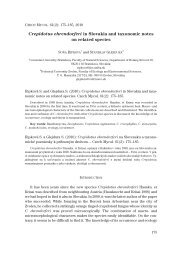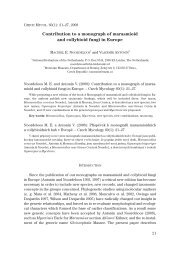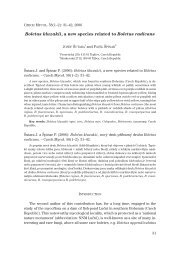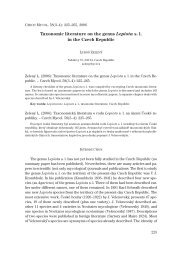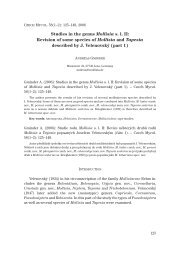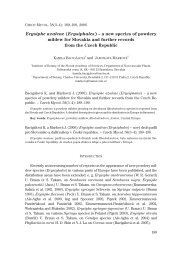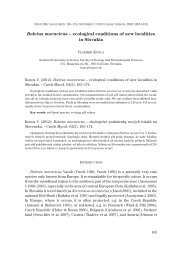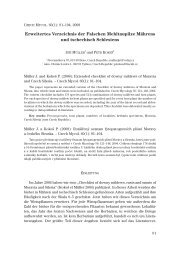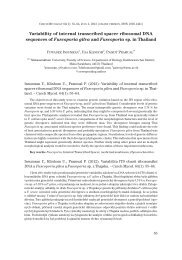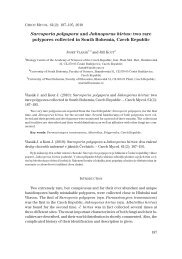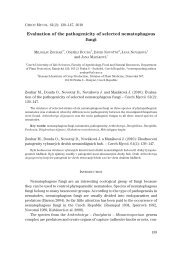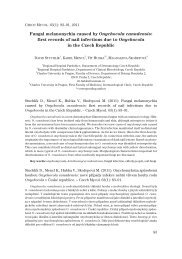Rigidoporus pouzarii, a new polypore species related - CZECH ...
Rigidoporus pouzarii, a new polypore species related - CZECH ...
Rigidoporus pouzarii, a new polypore species related - CZECH ...
You also want an ePaper? Increase the reach of your titles
YUMPU automatically turns print PDFs into web optimized ePapers that Google loves.
<strong>CZECH</strong> MYCOLOGY 64(1): 3–11, JULY 2, 2012 (ONLINE VERSION, ISSN 1805-1421)<strong>Rigidoporus</strong> <strong>pouzarii</strong>, a <strong>new</strong> <strong>polypore</strong> <strong>species</strong> <strong>related</strong> to<strong>Rigidoporus</strong> crocatusPETR VAMPOLA 1 , JOSEF VLASÁK 21 Smrčná 109, 588 01 Smrčná u Jihlavy, Czech Republic;vampolapetr@volny.cz2 Biology Centre of the Academy of Sciences of the Czech Republic,Institute of Plant Molecular Biology, Branišovská 1160/31, CZ – 370 05 České Budějovice, Czech Republic;vlasak@umbr.cas.czVampola P., Vlasák J. (2012): <strong>Rigidoporus</strong> <strong>pouzarii</strong>, a <strong>new</strong> <strong>polypore</strong> <strong>species</strong> <strong>related</strong>to <strong>Rigidoporus</strong> crocatus. – Czech Mycol. 64(1): 3–11.The <strong>new</strong> <strong>polypore</strong> <strong>Rigidoporus</strong> <strong>pouzarii</strong> Vampola et Vlasák is described, occurring in alluvial forests,forming annual resupinate fruitbodies on lying dead stems of hardwoods, mostly Alnus <strong>species</strong>. InEurope, the <strong>species</strong> has been probably misidentified as R. crocatus, a closely <strong>related</strong> <strong>species</strong> differingby perennial, multi-layered fruitbodies and occurrence in old-growth mountain forests, preferentiallyon logs of Abies alba. Diagnostic features of both <strong>species</strong> are discussed and DNA sequences are alsoadded. The name is dedicated to Zdeněk Pouzar, distinguished Czech mycologist, expert in alluvial forestfungi and our excellent teacher, on the occasion of his 80th birthday.Key words: <strong>Rigidoporus</strong>, taxonomy, internal transcribed spacer, alluvial forest fungi.Vampola P., Vlasák J. (2012): <strong>Rigidoporus</strong> <strong>pouzarii</strong>, nový druh chorošů příbuzný<strong>Rigidoporus</strong> crocatus. – Czech Mycol. 64(1): 3–11.Je popsán nový druh chorošů <strong>Rigidoporus</strong> <strong>pouzarii</strong> Vampola et Vlasák, který roste v lužních lesícha tvoří jednoleté rozlité plodnice na ležících kmenech výhradně listnáčů, nejčastěji olší. V Evropěbyl tento druh dosud zaměňován s příbuzným R. crocatus, který se však liší víceletými vrstevnatýmiplodnicemi a růstem převážně na ležících kmenech Abies alba v horských pralesích. Hlavní rozdílné diagnostickéznaky obou druhů jsou diskutovány a je připojena molekulární charakteristika. Nový druhje věnován Zdeňku Pouzarovi, významnému českému mykologovi, nadšenému znalci hub lužních lesůa našemu obětavému učiteli, k jeho 80. narozeninám.INTRODUCTIONSince the beginning of the 1990s, our survey of polyporoid fungi in alluvial forestnature reserves Šúr near Bratislava (Slovakia) and Ranšpurk near Lanžhot(Czech Republic) have yielded repeatedly a strange <strong>Rigidoporus</strong> <strong>species</strong> whichwas at first considered a lowland, annual form of R. crocatus (Pat.) Ryvarden[syn. R. nigrescens (Bres.) Donk]. In contrast to the perennial, distinctly multi-layeredand “café-au-lait” coloured fruitbodies of R. crocatus, this fungus always createsannual fruitbodies which are at first whitish or light yellow-pinkish (Fig. 3)3
<strong>CZECH</strong> MYCOLOGY 64(1): 3–11, JULY 2, 2012 (ONLINE VERSION, ISSN 1805-1421)showing striking red spots after bruising (Fig. 4) and only later acquire the typical“café-au-lait” colour (Fig. 5). Molecular analysis confirmed that it is a different<strong>species</strong> which is described here as <strong>new</strong> to science.MATERIALS AND METHODSM a c r o s c o p i c a n d m i c r o s c o p i c s t u d y. Macroscopical and microscopicalcharacters were studied on fresh fruitbodies and herbarium specimensdeposited in the herbaria PRM (National Museum Prague, Mycological Department,Czech Republic), MJ (Muzeum Vysočiny, Jihlava, Czech Republic), CWUFig. 1. <strong>Rigidoporus</strong> <strong>pouzarii</strong> (PRM 899856, holotype). A – basidia, B – spores, C – fusoid cystidioles,D – hyphoid cystidia. Del. P. Vampola.4
VAMPOLA P., VLASÁK J.: RIGIDOPORUS POUZARII, A NEW POLYPORE SPECIES(V.N. Karasin National University, Kharkiv, Ukraine), and in the private herbaria ofboth authors. Microscopic characteristics were observed in Melzer’s reagent andCotton Blue under Olympus BX41 and Meopta D816Bi microscopes with an oil immersionlens at a magnification of 1000×. A total of 20 spores from each specimenwere measured.D N A i s o l a t i o n a n d s e q u e n c i n g . The fungal tissue (0.25 g) was disintegratedfor 60 s with an MM301 (Retch) steel ball mixer mill at room temperature.DNA was isolated using the CTAB/NaCl extraction buffer as described byMurray and Thompson (1980), followed by repeated extraction with chloroformand isopropanol precipitation. Crude DNA was dissolved in 100 μl of sterile waterand further purified using the Wizard Clean Up kit (Promega). The resulting DNAsolution (50 μl) was diluted ten times and 1 μl was used as a template for PCR amplificationwith the ITS5 and ITS4 primers (White et al. 1990) in 25 μl reaction mixtureusing 55 °C annealing temperature. Amplified DNA was sequenced in theGenomics laboratory of the Biology Centre, Academy of Sciences of the Czech Republic,České Budějovice, on an ABI 3730xl DNA analyzer, using the BigDye Terminator3.1 kit.P h y l o g e n e t i c a n a l y s i s . The sequences were aligned with Clustal X andmanually pruned. The evolutionary history was inferred by using the MaximumLikelihood method based on the Tamura-Nei model (Tamura and Nei 1993). Initialtree(s) for the heuristic search were obtained using the BIONJ method with anMCL distance matrix. All positions containing gaps and missing data were eliminatedfrom the dataset (complete deletion option). The final dataset containeda total of 573 positions, which included 485 constant and 88 variable sites. Phylogeneticanalyses were conducted in MEGA5 (Tamura et al. 2011).RESULTS AND DISCUSSION<strong>Rigidoporus</strong> <strong>pouzarii</strong> Vampola et Vlasák, spec. nov.(MycoBank MB 564573)D i a g n o s i s l a t i n a . Carposomata annua, resupinata, primo albidula, dein pallide rosea; poriangulato-rotundati, parvi, cca 5–7 per 1 mm; systema hypharum monomiticum, cum hyphis generativishyalinis, tenuiter tunicatis usque crasse tunicatis, efibulatis; hymenium e basidiis, cystidiolis etcystidiis constat; hyphoidea cystidia tenuiter tunicata, hyalina, apicibus incrustati; basidiosporae4,7–6,3 × 4–4,6 μm, globoso-ovoideae vel breviter ellipsoideae, hyalinae. Ad ligna arborumfrondosarum. Habitu macroscopico Rigidoporo crocato similis, sed carposomata annua.H o l o t y p u s . Slovacia, Svätý Jur, area tuta “Šúr”, 15 km sept.-or. versusBratislava, alt. 130 m s. m., Alnus glutinosa – ad truncum iacentem, 19.VI. 2004leg. P. Vampola no. 2704 [holotypus in herbario Musei Nationalis Pragae (PRM899856) asservatur (GenBank JQ409462)]; i s o t y p u s in herbario Musei Iglaviensis5
VAMPOLA P., VLASÁK J.: RIGIDOPORUS POUZARII, A NEW POLYPORE SPECIESEcology. On fallen dead trunks of hardwoods (Acer campestre, Alnusglutinosa,Carpinus betulus, Ulmus laevis) in lowland forests of warmer regions,at altitudes up to 150 m. All existing records are from nature reserves of alluvialold-growth forests with a long history of vegetation continuity. In the Czech Republic,the only known habitat can be characterised as hardwood forest of lowlandrivers (altitude 150 m); habitats in Slovakia and Ukraine as alder carrs (altitude130 and 100 m). Although undoubtedly a very rare <strong>species</strong>, <strong>Rigidoporus</strong><strong>pouzarii</strong> occurs at both Czech and Slovak localities each year on about ten fallentrunks in all stages of decay, causing a white rot. Fruitbodies grow from spring toautumn, exceptionally also in mild winters, and are annual, with only one layer oftubes. Quite seldom, in early spring, fragments of withered tubes of the precedingyear can be seen under <strong>new</strong>ly developed fresh fruitbodies.D i s t r i b u t i o n . Currently known from the Czech Republic, Slovakia andUkraine. It probably occurs also in alluvial forests in other countries and not onlyin Europe, but it is erroneously being identified as R. crocatus (= R. nigrescens).Notes. <strong>Rigidoporus</strong> <strong>pouzarii</strong> is undoubtedly closely <strong>related</strong> to R. crocatus,differing macroscopically by annual, at first whitish or pale pinkish fruitbodieswhich show a striking red staining after bruising. Although we could not study thetype of R. crocatus collected in Tunis on Quercus mirbeckii (Patouillard 1894),we accept its presumed identity with Poria nigrescens Bres., as published byRyvarden (1983). In his original description, Patouillard did not mention the multilayercharacter of its fruitbodies, but he described the tubes to be up to 10 mmlong in the centre and much shorter towards the margin. This is also typical ofP. nigrescens fruitbodies. The photos of typical multi-layered P. nigrescens werepublished on the Internet (Vlasák 2011). Bresadola described P. nigrescens usinga collection from Abies alba, Mt. Sitno, Slovakia, a locality well known to us. Similarlyas in other mountain old-growth forests of the Czech and Slovak Republics,<strong>Rigidoporus</strong> crocatus (= R. nigrescens) grows here making multi-layeredfruitbodies mostly on fallen logs of Abies alba and only rarely on hardwoods.<strong>Rigidoporus</strong> <strong>pouzarii</strong> prefers warmer regions, where it grows on lying hardwoodlogs, most often alders (especially Alnus glutinosa). A very similar <strong>species</strong> is alsoPoria endoxantha Petch described in 1922 from Ceylon and known also fromFlorida, USA (Lowe 1966). This <strong>species</strong> has, however, thick-walled cystidia. Thecystidia are always thin-walled in <strong>Rigidoporus</strong> <strong>pouzarii</strong>. According to Corner(1987) Poria endoxantha is identical with <strong>Rigidoporus</strong> albostygius (Berk. etM.A. Curtis) Rajchenb., a taxon now placed in the synonymy of R. vinctus (Berk.)Ryvarden. In our opinion, the identity of Poria endoxantha should be re-evaluatedusing modern molecular methods. After many years of studying abundantfresh and herbarium material we conclude that the mycological literature containsmany inaccurate data and mistakes in <strong>Rigidoporus</strong> <strong>species</strong> descriptions,and many misinterpretations of <strong>species</strong>, making the identification of some collec-7
<strong>CZECH</strong> MYCOLOGY 64(1): 3–11, JULY 2, 2012 (ONLINE VERSION, ISSN 1805-1421)tions very difficult. Also from Asia (Cui et al. 2009, Dai 1998, Núñez & Ryvarden1999, Núñez et al. 2001) several <strong>new</strong> <strong>species</strong> with confusingly similar featureswere recently described, which we have not been able to study so far. Accordingly,we are preparing a more extensive and more fundamental study of the<strong>Rigidoporus</strong> / Physisporinus <strong>species</strong> complex to be published later.ITS sequence analysisThe ITS rRNA region of eight <strong>Rigidoporus</strong> <strong>pouzarii</strong> specimens from threeknown localities were sequenced together with three specimens of R. crocatusfrom Abies alba and Fagus sylvatica (Fig. 2). The tropical <strong>Rigidoporus</strong> vinctus(Berk.) Ryvarden with similar basidiomes, hyphae and spores but no colourchange and with thick-walled cystidia was also included in the study to root thetree.The ITS1 and ITS2 regions of R. <strong>pouzarii</strong> and R. crocatus show the samelength but the sequence variation is considerable. A 10% (19/200) difference in theITS1 and 5% (10/196) in the ITS2 region between R. <strong>pouzarii</strong> and R. crocatus wasdetected. This suggests two well-separated <strong>species</strong>. Among different R. <strong>pouzarii</strong>specimens, the sequence is identical except for five heterozygous sites.Specimens examined<strong>Rigidoporus</strong> crocatus. C z e c h R e p u b l i c . Novohradské hory Mts.: Žofín (distr. Český Krumlov),Žofínský prales Nature Reserve, alt. 760 m, on fallen trunk of Abies alba, 19. IX. 2010 leg. et det. P.Vampola (MJ 38/10, GenBank JQ409467); ibid., on fallen trunk of Fagus sylvatica (MJ 42/10).S l o v a k i a . Veporské vrchy Mts.: Čierny Balog (distr. Brezno), Dobročský prales Nature Reserve, alt.900 m, on fallen trunk of Abies alba, 26. IX. 2009 leg. et det. P. Vampola (MJ 19/09, GenBank JQ409466);Kremnické vrchy Mts.: Badín (distr. Banská Bystrica), Badínský prales Nature Reserve, alt. 700 m, onfallen trunk of Abies alba, 28. IX. 2009 leg. et det. P. Vampola (MJ 33/09).<strong>Rigidoporus</strong> <strong>pouzarii</strong>. C z e c h R e p u b l i c . Lanžhot (distr. Břeclav), Ranšpurk Nature Reserve,alt. 150 m, on fallen trunk of Ulmus laevis, 3. VI. 1964 leg. F. Kotlaba et Z. Pouzar, VII. 1971 det. Z.Pouzar as <strong>Rigidoporus</strong> nigrescens (PRM 627557), ibid., on fallen trunk of Alnus glutinosa, 20. XI. 1996leg. et det. P. Vampola (MJ 397/96); ibid., 22. X. 1998 leg. et det. P. Vampola (MJ 60/98); ibid., on fallentrunk of Acer campestre, 20. X. 2001 leg. et det. P. Vampola (MJ 27/01); ibid., on fallen trunk ofCarpinus betulus, 2. III. 2002 leg. et det. P. Vampola (MJ 6/02, 7/02); ibid., on fallen hardwood trunk, 19.XI. 2005 leg. et det. J. Vlasák (JV0511/23, GenBank JQ409465). S l o v a k i a . Svätý Jur (distr. Bratislava),Šúr Nature Reserve, alt. 130 m, on fallen trunk of Alnus glutinosa, 19. VI. 2004 leg. P. Vampola(holotypus: PRM 899856, GenBank JQ409462), ibid., 12. X. 1993 leg. et det. P. Vampola as <strong>Rigidoporus</strong>nigrescens (paratypus: Pol. Exs. Čech. 123, MJ 600/93-3326, GenBank JQ409464), ibid., 12. X. 1995 leg.et det. P. Vampola (MJ 326/95, GenBank JQ409463). U k r a i n e . Kharkiv Region, Balaklea District,Syverskyi Donets River floodplain, Iziumska luka Regional Landscape Park, alt. 100 m, on fallen trunkof Alnus glutinosa, 6. XI. 2010 leg. A.Yu. Akulov and A.V. Ordynets, 4. I. 2012 det. A.V. Ordynets as<strong>Rigidoporus</strong> crocatus (CWU/Myc/5674, GenBank JQ733558).<strong>Rigidoporus</strong> vinctus. M e x i c o . Los Tuxtlas Reserve, hardwood, 12. X. 2006 leg. J. Kout, det.J. Vlasák (JV0610/A31B, GenBank JQ409460, JQ409461). B e l i z e. Cockscomb Basin, hardwood, 27. X.2006 leg. J. Kout, det. J. Vlasák (JV0610/B5, GenBank JQ409459).8
VAMPOLA P., VLASÁK J.: RIGIDOPORUS POUZARII, A NEW POLYPORE SPECIESFig. 3. <strong>Rigidoporus</strong> <strong>pouzarii</strong> (PRM 899856, holotype), juvenile fruitbody. Slovakia: Svätý Jur nearBratislava, Šúr Nature Reserve, Alnus glutinosa, 19. VI. 2004. Photo: P. Vampola.Fig. 4. <strong>Rigidoporus</strong> <strong>pouzarii</strong> (PRM 899856, holotype), juvenile fruitbody when bruised. Slovakia:Svätý Jur near Bratislava, Šúr Nature Reserve, Alnus glutinosa, 19. VI. 2004. Photo: P. Vampola.9
<strong>CZECH</strong> MYCOLOGY 64(1): 3–11, JULY 2, 2012 (ONLINE VERSION, ISSN 1805-1421)Fig. 5. <strong>Rigidoporus</strong> <strong>pouzarii</strong> (JV0511/23), mature fruitbody. Czech Republic: Lanžhot (distr. Břeclav),Ranšpurk Nature Reserve, on fallen hardwood trunk, 19. XI. 2005. Photo: J. Vlasák.Fig. 6. <strong>Rigidoporus</strong> <strong>pouzarii</strong> (MJ 600/93-3326, paratype), fragment of dry fruitbody. Slovakia: SvätýJur near Bratislava, Šúr Nature Reserve, Alnus glutinosa, 12. IX. 1993. Photo: P. Vampola.10
VAMPOLA P., VLASÁK J.: RIGIDOPORUS POUZARII, A NEW POLYPORE SPECIESACKNOWLEDGEMENTSThe authors thank Dr. J. Kout (Plzeň, Czech Republic) and A.V. Ordynets(Kharkov, Ukraine) for loaning R. vinctus and R. <strong>pouzarii</strong> specimens, and anonymousreviewers for valuable comments.REFERENCESCORNER E.J.H. (1987): Ad Polyporaceas, IV. – Beih. Nova Hedwigia 86: 1–286.CUI B.K., DAI Y.C., LI B.D. (2009): Notes on the genus <strong>Rigidoporus</strong> (Basidiomycota, Polyporaceae) inChina. – Nova Hedwigia 88: 189–197.DAI Y.C. (1998): Changbai wood-rotting fungi 9. Three <strong>new</strong> <strong>species</strong> and other <strong>species</strong> in <strong>Rigidoporus</strong>,Skeletocutis and Wolfiporia (Basidiomycota, Aphyllophorales). – Ann. Bot. Fennici 35: 134–154.LOWE J.L. (1966): Polyporaceae of North America. The genus Poria. – State Univ. N.Y. Coll. For. Tech.Publ. 90: 1–183.MURRAY M.G., THOMPSON W.F. (1980): Rapid isolation of high molecular weight plant DNA. – Nucl. AcidsRes. 8: 4321–4326.NÚÑEZ M., RYVARDEN L. (1999): New and interesting <strong>polypore</strong>s from Japan. – Fungal Diversity 3:107–121.NÚÑEZ M., PARMASTO E., RYVARDEN L. (2001): New and interesting <strong>polypore</strong>s from East Russia. – FungalDiversity 6: 107–114.PATOUILLARD M.N. (1894): Quelques espèces nouvelles de champignons du nord de l’ Afrique. – Jour.Bot. (Morot) 8: 219–221.RYVARDEN L. (1983): Type studies in the Polyporaceae 14. Species described by Patouillard, eitheralone or with other authors. – Occ. Papers Farlow Herb. Crypt. Bot. 18: 1–39.TAMURA K., NEI M. (1993): Estimation of the number of nucleotide substitutions in the control region ofmitochondrial DNA in humans and chimpanzees. – Mol. Biol. Evol. 10: 512–526.TAMURA K., PETERSON D., PETERSON N., STECHER G., NEI M., KUMAR S. (2011): MEGA5: Molecular EvolutionaryGenetics Analysis using Maximum Likelihood, Evolutionary Distance, and MaximumParsimony Methods. – Mol. Biol. Evol. 28: 2731–2739.VAMPOLA P. (1995): Polyporales exsiccati Čechoslovaciae, Fasc. V., No. 123 – <strong>Rigidoporus</strong> nigrescens.VLASÁK J. (2011): Polypores – Collection of Dr. Josef Vlasák, Hluboká nad Vltavou, Czech Republic. –http://mykoweb.prf.jcu.cz/<strong>polypore</strong>s [accessed 15 April 2011]WHITE T.J., BRUNS T.D., LEE S., TAYLOR J.W. (1990): Amplification and direct sequencing of fungal ribosomalRNA genes for phylogenies. – In: Innis M.A., Gelfand D.H., Sninsky J.J., White T., eds., PCRprotocols: a guide to methods and applications, p. 135–322, San Diego.11



